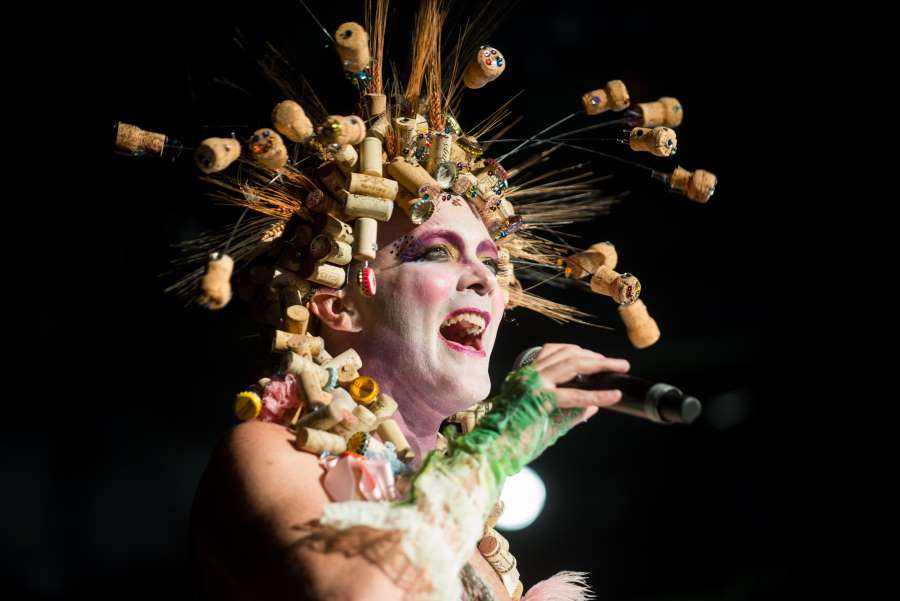“It’s going to go on a lot longer than you’re going to want it to.”
Taylor Mac, the gender-bending performance artist, instructed the audience to stand up, wave their hands in the air, and start speaking in tongues. It was the first hour of his magnum opus, A 24-Decade History of Popular Music, at St. Ann’s Warehouse on Oct. 8-9, and considering it was a “radical faerie realness ritual,” a cleansing had to happen before we could proceed into the unknown.
Mac would use this cautionary phrase throughout the pulsating 24 hours: making the audience mime rowboats, breathe heavy “ha”s during “O Superman,” create a zombie apocalypse. While it would be easy to joke that the warning could also refer to the show itself—24 consecutive hours is a long time to spend in a theatre—that was not the case. Even with no formal intermissions, about 600 people stayed rapt for the full running time. (Mac performed the show in three-decade acts, of which there are eight, at St. Ann’s Sept. 15-Oct. 3.) Here is my hour-by-hour account of what went down.
Saturday, 12:00 p.m. (1776-1786)
A long line winds through the St. Ann’s lobby, around a series of naked mannequins that will later sport the array of costume concoctions (one for every hour/decade) by Machine Dazzle as the show unfolds. Things get underway a little late, but when music director Matt Ray, who created the arrangements for all the songs and plays piano, takes the stage to cue the 24 musicians (one will leave the group each hour), the house erupts. Mac struts in to a rapturous ovation, belting “Amazing Grace,” as if he doesn’t have 245 more songs to sing. Given that the show charts mostly American history, Mac wants to begin by honoring the land’s native inhabitants, bringing up Timothy White Eagle, who would go on to serve as a Dandy Minion throughout the performance. (The Dandy Minions are a group of Mac’s “assistants,” of sorts, who help the audience through the experience, distributing props, clearing fire exists, and performing onstage with Mac.) Mac apologizes for our ancestors’ hatred and violence toward the land’s native people, acknowledging that we also inherit what came before and offering up his grandmother’s ukulele to White Eagle. Most memorable song of the hour: “Yankee Doodle Dandy,” which the British sang to mock what they considered Americans’ effeminacy—and which the Americans then turned back on British after they won the Revolutionary War. “Dandy” will be a recurring motif through the show. Bonus: Mac has people knitting onstage for this act, as America was founded on making things.
1:00 p.m. (1786-1796)
I had no idea the women’s liberation movement started this early. This show is definitely a history lesson in addition to a concert/performance art piece/extravaganza. One of the more memorable moments from this hour is when Mac emerges from behind the changing partition wearing two working steam stacks on his back, only to have one quickly fall off and spill water all over the stage. “Clean up on aisle five,” Mac quips. A stagehand arrives quickly with a towel, but Mac insists on wiping it up—this was the women’s decade, after all. The song that keeps ringing through my head from this decade is “Oh Dear, What Can the Matter Be?,” which opens the set and is reprised. Guitarist Vivian Viva DeConcini also performs an epic guitar solo during “Rights of Women,” backed by a women’s choir.
2:00 p.m. (1796-1806)
Time for some drinking songs! While the audience remains almost completely sober throughout the concert—staying awake is more important—this decade marks the beginnings of the temperance movement. Mac takes on the character of “Crazy Jane”—also the name of one of the songs in the set—whom he describes as that mad queer who, when you spot them at the bar, is a sign that it’s going to be a legendary night. Mac tells stories from his time cutting his teeth in downtown clubs, and he finds a dichotomy among his audiences now that he performs at places like St. Ann’s, the Public Theater and others. His goal for the decade is to merge different kinds of people in the audience—and to let them throw ping pong balls at a temperance choir, played by actual choir Choral Chameleon. “Everything you’re feeling is appropriate,” Mac assures the audience, another adage that will come up again and again.
3:00 p.m. (1806-1816)
To cover the next three decades, Mac has created a frame for the era’s songs in the form of Harry/Jane, an “original jukebox musical” that we’re seeing in “a workshop of a workshop for the backer’s audition for the not-for-profit, out-of-town run, for the Broadway premiere, for the Oscar-winning film.” Mac tells us his goal is to subvert the heteronormative narrative.
4:00 p.m. (1816-1826)
This hour of the “heteronormative jukebox musical” includes a dream sequence, for which the Dandy Minions hand out sleep masks to the entire audience. (We also move most of the chairs out of the way.) Mac instructs the audience not to take off their blindfolds for the entire time, but adds, “There are no gun cues in this show. So if you hear gunfire, take off your fucking blindfold.” In this hour I shove a flower in another audience member’s face, sit on someone’s lap, and feed a tall person a grape and get fed one by him (this was during the song “Cherry Ripe,” but cherries aren’t in season). At the end, when we take off our blindfolds, Mac, clad in a pastel gown covered in pastel balloons, says, “You’re looking for the dandy,” as he stands in the Dandy Boudoir, a balcony of mattresses where up to 50 people at a time can go.
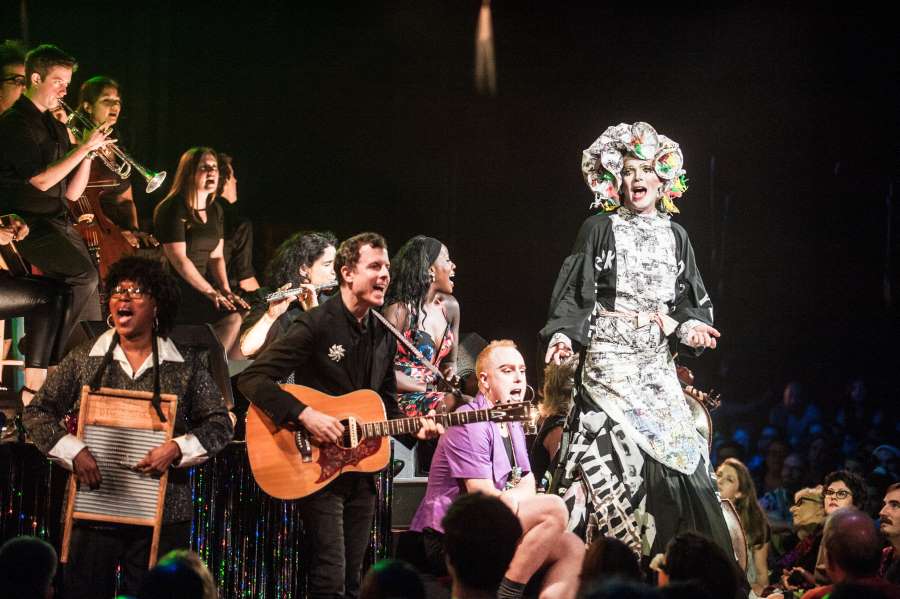
5:00 p.m. (1826-1836)
Mac goes from school marm to murder-ballad vixen in this decade, as he chronicles the Trail of Tears and the Indian Removal Act. We also go through Oklahoma, for which he used some terrible fluorescent lighting. (The show’s lighting by John Torres is transformative throughout.) The only songs I can remember from this decade are “Cotton-Eyed Joe” and “Turkey in the Straw.” (Noted: Mac’s murder ballad headdress has two turkeys on it.)
6:00 p.m. (1836-1846)
Enter the abolitionist movement. Eric F. Avery’s puppetry is the star of this hour, and puppets “swim” through the audience to portray the slaves’ flight. Mac even wears a huge river as part of his costume. He also highlights the work of the Hutchinson Family Singers, including “Get Off the Track.” (The songs are very peppy, though Mac comments that they didn’t exactly spur much actual abolition at the time.)
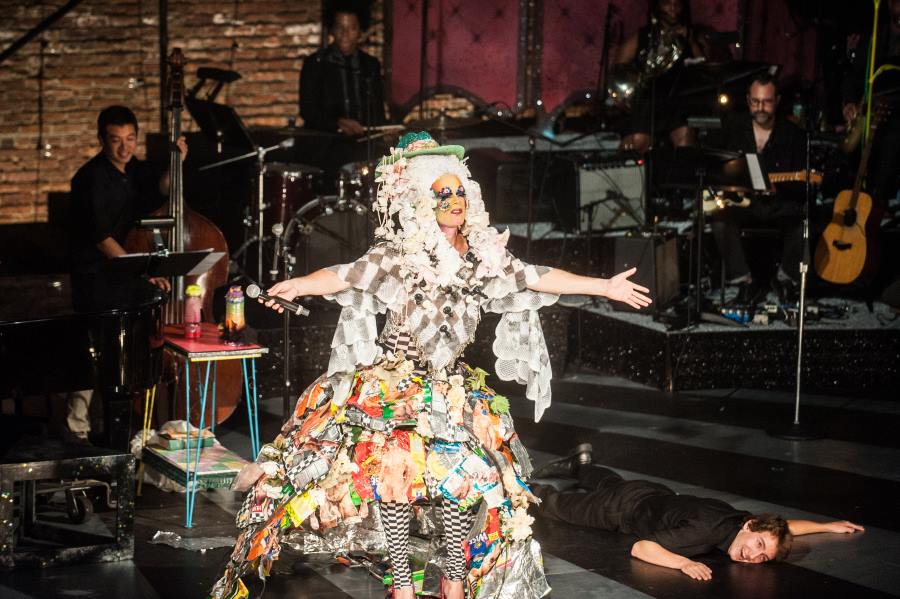
7 p.m. (1846-1856)
This hour is devoted to a battle over the title of “father of American Song” between Stephen Foster and Walt Whitman. Mac frames the entire section as a boxing match between the two and has an audience member (choreographer Chase Brock) sit in a mini boxing ring in the middle of the audience for the duration. Mac pairs such Foster classics as “Oh Susanna” and “My Old Kentucky Home” in four “boxing rounds” with excerpts from Whitman’s “Song of Myself.” Mac solicits audience applause to see who wins each round, and Whitman comes out way ahead—to which Mac responds with a Foster earworm. (Taylor Mac is right: Days laterI still will not be able to get “Camptown Races” out of my head. Luckily, I will have Brock’s high-energy dance-off to the tune in my memory now as well.)
8 p.m. (1856-1866)
The Civil War is upon us, and true to his earlier statement about no gun cues, Mac arms the audience with ping pong balls and divided the audience into Confederate and Union soldiers. (“You are not playing yourself, you are playing a character!” Mac repeatedly reminds the audience during this hour and throughout the evening.) As we lob our “weapons” at each other, Mac instructs us to stop using an arm if a ball hits it, or to “die” if a ball hits us in the head or heart. It becomes increasingly hard to tell who is in the Union and who is in the Confederacy as the battle wears on. Mac sings songs that were important to different groups of soldiers during the time, and ends with a rousing rendition of “When Johnny Comes Marching Home.”
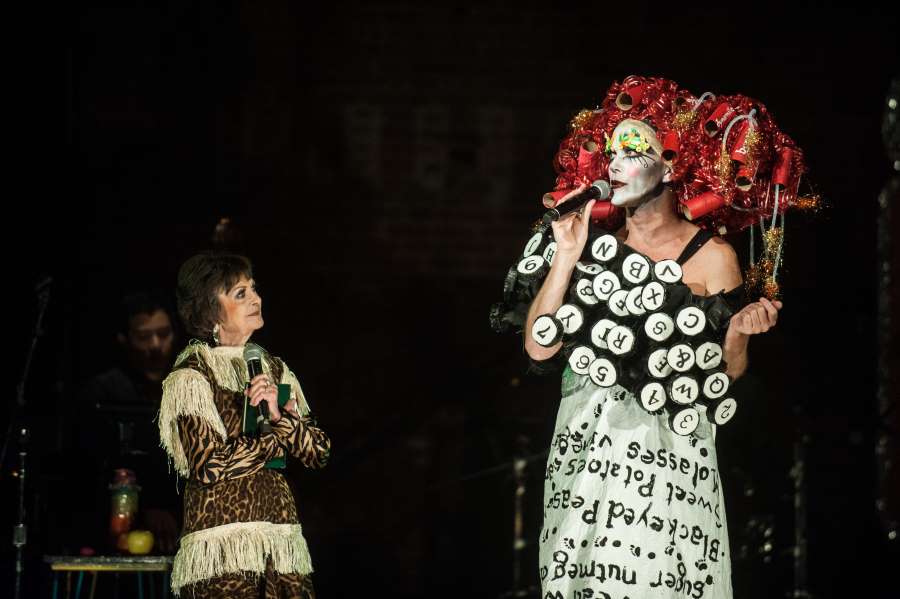
9 p.m. (1866-1876)
Dinner time! Audience members are served a period-appropriate meal of a green salad, black-eyed peas and squash, cornbread, cherry tomatoes, and turnips. (One group is designated as the “Labor Party” and serves food to everyone. Everyone helps bring the chairs back.) We move the chairs again, as tables are brought out for some of the audience. The decade marked Reconstruction after the war, and Mac has his voice teacher, Barbara Maier Gustern, play the role of “Mother” to say grace for dinner. LAVA, a feminist acrobatic dance troupe, also provides some entertainment. The most well-known songs from the hour are the opening “Down by the Riverside” and “Home on the Range,” and the most memorable moment might be audience members carrying Mac from table to table (and almost dropping him).
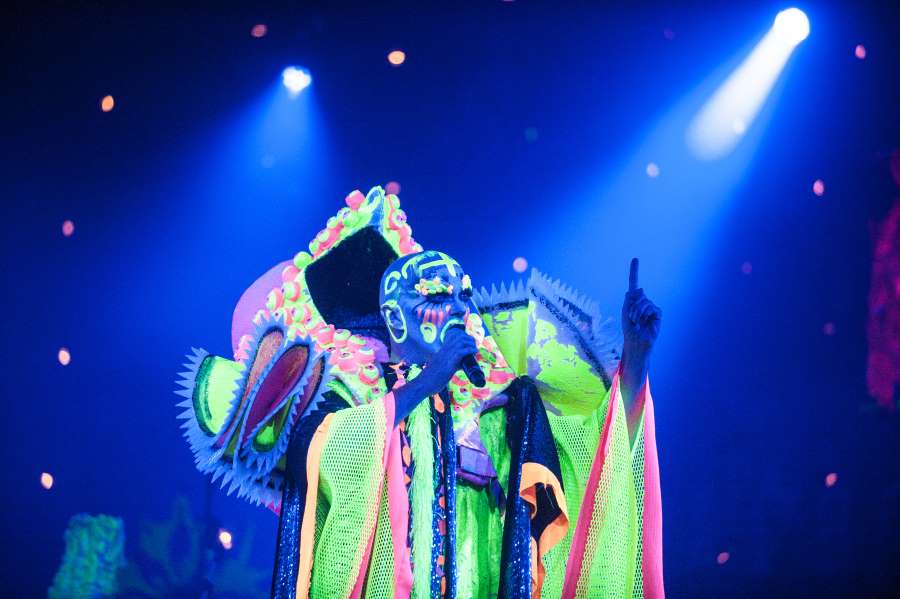
10 p.m. (1876-1886)
This decade might take the cake as the most memorable of all 24, as Mac spends the entire hour performing a dinner theatre version of Gilbert and Sullivan’s The Mikado. Since it’s problematic for white actors to portray the show’s faux-Japanese characters, Mac has transposed the story to Mars to grapple with the show’s themes of colonialism and the merging of cultures, and dubbed the result The Marskado. The glow-in-the-black-light costumes and voice-changing microphones just add to the delight. Mac portrays Nanki-Poo, a poor musician, and has an audience member come onstage to play Yum-Yum, Nanki-Poo’s secret love. The audience member has his own costume and wears a headset feeding him choreography and lines. (The headset doesn’t work at first, so for the dance, the audience member follows one of the Dandy Minions in the booth.) At the end, Mac makes the audience member repeat the phrase “Tit-Willow” for what seems like 10 minutes, to uncontrolled laughter from the audience.
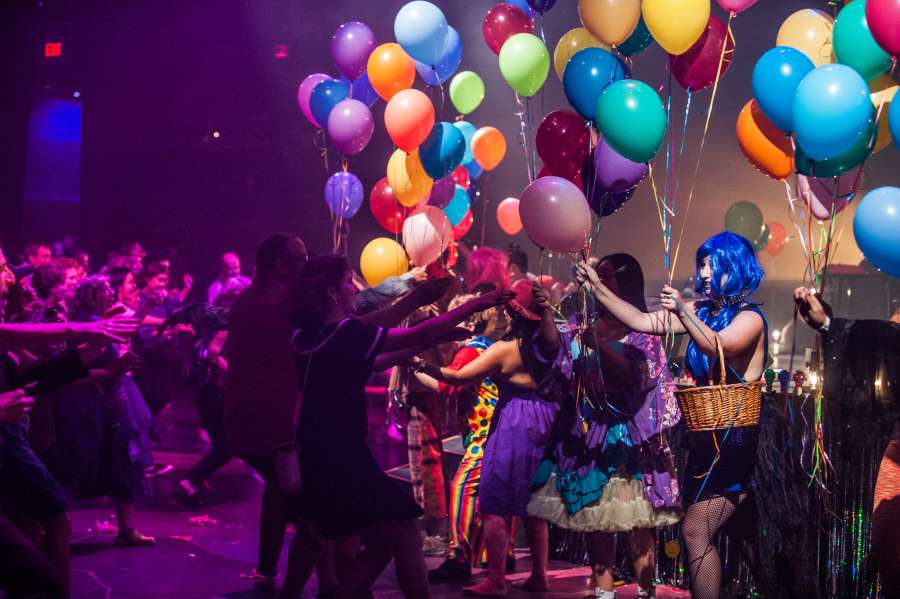
11 p.m. (1886-1896)
I am surprised no one gets hurt during this decade. We move the chairs again, and several balloons—though not enough for each audience member—are brought in. It’s time for the Oklahoma Land Rush and Manifest Destiny. The balloons represent land deeds, and there are orange outlines of land plots on the floor throughout the space. We have to rush to grab a balloon (I don’t manage to nab one), then bring that balloon to an open plot of land (I also come up emptyhanded). Everyone ends up just sitting on the ground, so it doesn’t matter a great deal, and Mac’s oompah-pah rendition of “After the Ball” is one of the highlights of the whole event. ( “She’ll Be Coming ‘Round the Mountain” is pretty great too.)
Sunday, 12 a.m. (1896-1906)
Bring out the mattresses! (And sleeping bags.) While there are no breaks in the performance, the Dandy Minions bring out mattresses for the audience, as this decade focuses on Eastern European immigration to the United States and the Jewish tenements where many of these immigrants lived. Several people pile onto each mattress, and—I gotta be honest—I definitely lay down and fall asleep for a bit.
1 a.m. (1906-1916)
I wake up at 1:30 a.m. in the midst of World War I. Mac has asks all of the men in the audience, aged 14-40, to come onstage to represent the draft. He has them pretend to be in the trench together and gives them a bottle of whiskey to pass around—though very few take a drink. He also has the audience join him in singing “I Didn’t Raise My Boy to be a Soldier/It’s Time for Every Boy to be a Soldier,” about the divided opinion on the draft. I drift off to sleep again as Mac sings “Keep the Home Fires Burning.”
2 a.m. (1916-1926)
I can’t stay asleep for long, as now we’re in a 1920s speakeasy. I wake up to Mac singing “Happy Days Are Here Again,” crystallizing American’s can-do spirit after the devastating war. I hate to say it, but I fall asleep one more time after this…
3 a.m. (1926-36)
I wake up in the middle of the Great Depression, with audience members lining up for pea soup and bread. It’s also the Harlem Renaissance, so after soup, Mac has audience members swing-dance to an instrumental version of “It Don’t Mean a Thing (If It Ain’t Got That Swing).” The entire audience sings “All of Me” together. My favorite part of this decade is when Mac recounts his days of dumpster diving, and brings out a real dumpster, pulls an ice cream cone costume out of it, and sings “Napoleon’s a Pastry.” Genius.
4 a.m. (1936-1946)
I sleep through this entire decade, and I’m really bummed about it — apparently I miss Mac singing “Soliloquy” from Carousel. I also miss World War II. I think I might vaguely hear “Boogie Woogie Bugle Boy” as I drowse.
5 a.m. (1946-1956)
I wake up to Mac singing Roy Orbison’s “Pretty Woman,” dressed in a white picket fence. It’s the 1950s. I won’t fall asleep again (and it may sound like I slept a lot, but it’s really only been about two-and-a-half hours). They’ve taken the mattresses away, so it’sharder to lay my head down. We bring the chairs back out, and to illustrate the phenomenon of white flight to the suburbs, Mac has all the white audience members sit on the chairs on the side and all the people of color sit in the middle. White people are sitting in each other’s laps, while the people of color have plenty of space to lounge.
6 a.m. (1956-1966)
This might be my favorite hour/decade. It marks the start of Act 6 (the second to last), and Mac has two singers from Detroit, Stephanie Christi’an and Thronetta Davis, join him for the entire act. The three of them singing “Keep Me Hangin’ On” has me clapping and crying, as they illustrate what might have been sung on the bus to the historical Civil Rights March on Washington. (There are even members of the audience who had been a part of the March. “You deserve a better seat!” Mac tells one, moving him to the front row.) Mac sings Nina Simone’s “Mississippi Goddam.” Goddam indeed. Wow.
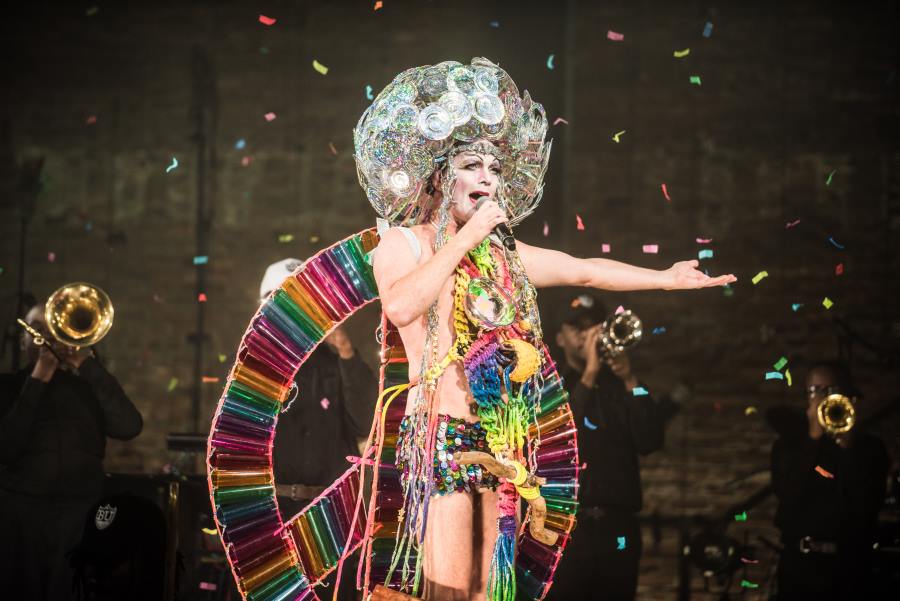
7 a.m. (1966-1976)
There is nothing like a marching band to wake up a sleepy audience. The Brooklyn United Marching Band comes out and performed “Move On Up.” Mac focuses on the milestone of the Stonewall riot and the music that bonded the gay community around that trauma—itself spurred by another trauma, the death of the icon Judy Garland . Mac has an audience member play “Dead Judy” as other audience members carry her in a funeral procession and he sings a gut-wrenching version of “Goodbye Yellow Brick Road.” Mac facilitates a “queer junior prom,” asking audience members to dance with a member of their same gender, while he sings “Snake-skinned cowboys” to metaphorically kill Ted Nugent, the conservative political activist and musician. “Oh my God,” Mac exclaims near the end of the hour. “We still have five hours.” The audience immediately leaps to their feet in support.
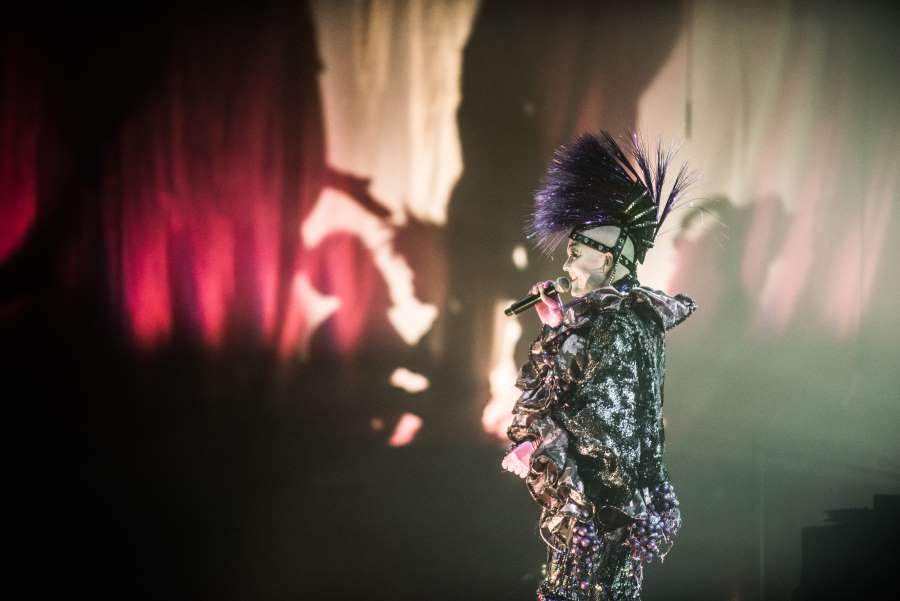
8 a.m. (1976-1986)
Now I can say I’ve seen everything. Mac themes this decade around a backroom sex party, confessing, “I love anonymous sex.” The hour ends with an enormous inflatable penis festooned with the American flag floating over the audience. A friend of mine gets pulled up onstage during “Gloria,” as Mac teaches the audience to mock people who shame us and the ways we shame ourselves. He sings David Bowie’s “Heroes” while the Dandy Minions simulate sex behind a scrim in the Dandy Balcony, and Christi’an and Davis bring down the house with their rendition of “Funky Dollar Bill.” Mac is starting to really hurt during this decade, and he almost forgets to sing “Purple Rain,” calling on the audience for help and making it through. One of the half-filled helium balloons from the Manifest Destiny decade wafts over the audience during this decade, and the entire audience, Mac included, just loses it. Loopiness is in full throttle.
9 a.m. (1986-1996)
It’s the beginning of the end—and for many people during this time period, it really was the end. Mac’s focus is the AIDS crisis. Machine Dazzle, who assists Mac in his costume changes onstage for almost every decade, comes out for the last time this hour, as Mac wants to sacrifice something major during this decade in tribute to the loss of that time. He wants to sing songs by out gay men at the time, remarking that he had trouble finding the songs. The revelation of the hour is when he sings Patti Smith’s “The People Have the Power.”
10 a.m. (1996-2006)
Welcome to the decade of the bull dyke. Mac devotes the entire decade to radical lesbians, whose movement took a back seat during the 1980s as they stepped up for gay men during the AIDS crisis. A UPS worker delivers Taylor’s costume for the hour and a small group of lesbians comes up onto the stage through a trap door. He invites singer/songwriter Anais Mitchell (Hadestown) onstage to sing with him, and then Mitchell invites all the female musicians from the performance to come back onstage and perform a riot grrrl song He also brings up Lesbian Avengers cofounder Sarah Schulman to read the “Lesbian Avengers Manifesto” as purple balloons with “Lesbian Lives Matter” written on them float around the room. At the end of the hour, Mac’s music director Ray leaves to a standing ovation and lots of tears.
11 a.m. (2006-2016)
This decade might have my favorite costume change. After 23 hours of performing, Mac still finds ways to surprise his audience. To enter this decade, Mac needs to “emerge from the womb,” so as a virtual “womb” lowers, he lifts his arms through the center and it becomes a golden dress. Mac sings original songs with a piano and a ukulele during this hour, remarking on death, existence, art, history, and more. “I’ve never been this hoarse before,” he says. “I wonder why.” The spectacle ends quietly with an encore on ukulele called “When All the Artists Leave or Die.” Of course there is a standing ovation and thunderous screams and claps, but Mac seems to be challenging his co-conspirators for the last 24 hours, his audience, to go out into the world and be the kind of person you want to meet and make the kind of things you want to see. While we might be broken down physically at the end of this marathon, we are— I am, at least—inspired to take on the world in a new way.

